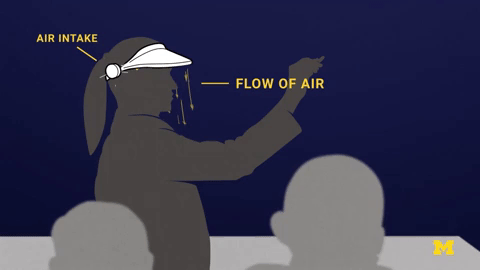Personal cold plasma “air curtain” design for COVID-19 protection moves forward
Medical giant Johnson & Johnson and federal HHS select U-M design with “minimal impact on daily life.”
Medical giant Johnson & Johnson and federal HHS select U-M design with “minimal impact on daily life.”
The next generation of protective masks—under development at the University of Michigan—could harness the power of non-thermal, or cold, plasma into a small headset that both blocks and neutralizes airborne pathogens.
Taza Aya LLC, a company founded by a U-M engineering professor, has been named an awardee in the Invisible Shield QuickFire Challenge, a competition created by Johnson & Johnson Innovation in cooperation with the U.S. Department of Health and Human Services’ Biomedical Advanced Research and Development Authority (BARDA). The program seeks protections from airborne viruses with minimal impact on daily life and the award was announced today at BARDA Industry Day.

Herek Clack, an associate professor of civil and environmental engineering, and Taza Aya’s CEO and co-founder, described his company’s concept as protection that aims to have “no restrictions to breathing or facial access.” The award comes with $200,000 in funding from BARDA.
“We’re looking to move beyond what everyone knows as the current standards for personal respiratory protections: the N95 masks, cloth masks and neck gaiters we’ve come to rely on in 2020,” Clack said. “These all rely on the conventional method of particle filtration via a largely impermeable medium.
“We’re looking at an entirely different paradigm here.”
The design features a visor-like device that takes in air from behind the wearer and inactivates all viruses via a miniaturized onboard cold plasma module. That air is then expelled from the visor, downward from the brow area, in front of the mouth and nose.
That downward rushing air serves as an “air curtain” that knocks down particles near the face before they can be inhaled. As such, Taza Aya’s design aims to tackle the two major problems with infectious aerosols: their infectivity and the ease with which they’re carried on air currents.
Fire is an example of a thermal plasma, one that has been used throughout history for sterilization. Non-thermal, or cold, plasmas are made of highly energetic radicals and ionized molecules that achieve a similar effect without the heat.
When airborne viruses are exposed to these charged particles, they are rendered harmless in a fraction of a second. Clack and his U-M research team previously demonstrated cold plasma’s ability to remove and kill 99.9% of airborne viruses in a farm setting as well as in the lab.
For Clack, the visor design represents the next step in research involving cold plasma as a replacement for particle filters as a means of preventing airborne disease transmission. In this iteration, the air curtain would not be appropriate for front-line medical personnel since it doesn’t protect against biofluids, as surgical masks do.
But for members of the wider public during the COVID-19 pandemic, an “air curtain” may be preferable to a traditional face covering.
The name Taza Aya means “fresh air” or “clean air” in Krygyz, the language spoken in Kyrgyzstan where co-founder and Chief Operating Officer Michael Drake spent time in the Peace Corps. Drake also serves as executive director of research and interim executive director of advancement for U-M’s College of Engineering.
Drake sees a host of potential uses for the design.
“We believe there is great value in providing situational access to the face while continuing to reduce the risk associated with aerosols” he said. “Dental and orthodontic activities provide great examples where patient based physical barrier risk reduction is not practical. Restaurant patrons do not have the ability to wear a mask the entirety of their experience – our air curtain will enable individuals to enjoy these environments with an added layer of protection.”